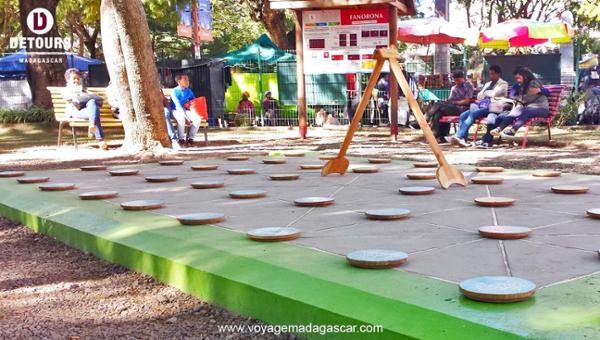
Fanorona: A blend of chess and checkers
Fanorona is a popular Malagasy board game often compared to checkers. When travelers in Madagascar pass by a street or park, it is highly likely that they will encounter groups of men gathered around a fanorona board.
This strategic game is shrouded in several legends. Some say it was created by Prince Andriantompokoindrindra in the 1600s, while others believe it was invented by the island's earliest inhabitants. The most plausible theory is that fanorona evolved from Alquerque, a game brought by Arab merchants. One of the oldest known fanorona boards, found in Antananarivo, is from Alasora, dating back to between 1500 and 1600.
Rules of the Fanorona game
Fanorona is played on a rectangular board with 5 rows and 9 columns. The interior consists of horizontal, vertical, and diagonal lines forming 45 points of intersection where the pieces are placed. Each player has 22 pieces (stones) placed on their side of the board. The central spot is where the first move is made. The objective is to capture all of the opponent’s pieces through two methods: percussion or aspiration.
- Percussion: Moving to an empty space in front of the piece to eliminate it.
- Aspiration: Moving backward toward the next available space to "suck" the piece away.
If pieces are lined up on the same axis, all of them are captured. If both capture methods are available, the player must choose one and confirm to the opponent which pieces will be removed, as the opponent removes them from the board.
Game progression and strategy
The first move involves placing a piece on the central spot, as there is only one possible move initially. After capturing, players can continue capturing other pieces as long as they move along a different line or axis from the previous one. However, they may also choose not to capture even if the opportunity exists.
At the start of the game, both percussion and aspiration are possible with the same move, giving the player a choice of which method to use. It is strategic to begin with small captures, as starting with large captures can leave many free spaces for the opponent, enabling them to make bigger captures later. Towards the end of the game, each player must take a turn, even if it doesn’t lead to a capture or places them in a disadvantageous position.

The importance of Fanorona to the Malagasy people
Fanorona in daily life
Fanorona is immensely popular and can be seen played everywhere: on the street, in parks, at home, or at taxi-brousse stations. The board can be drawn on a piece of wood, a flat stone surface, dirt, cardboard, or anything else that works. The pieces (called vato, meaning stones in Malagasy) are typically small rocks, pieces of wood, paper balls, chalk, or grains of different colors.
Although fanorona is mostly played by men to pass the time, relax, or unwind after work, it also serves to preserve a valuable cultural heritage. Because the game is highly addictive, some believe that certain fady (taboos) were created to prevent farmers from playing fanorona during the rainy season, as it was thought to distract them from their work.
Fanorona and Malagasy monarchs
Similar to the game of Go in Asia, fanorona was once used as a tool for military strategy training. It was also employed for divination. According to one legend, Queen Ranavalona III allegedly asked her advisors to play fanorona to predict the outcome of the battle with the French.
Another story from the early 17th century tells of one of King Ralambo’s sons missing an important succession meeting because he became too engrossed in playing fanorona. The game was widely practiced by the Malagasy aristocracy, especially by kings and queens, as evidenced by the large stone fanorona board at the Rova of Ambohimanga. King Andriamasinavalona (1675-1710) was particularly fond of the game.